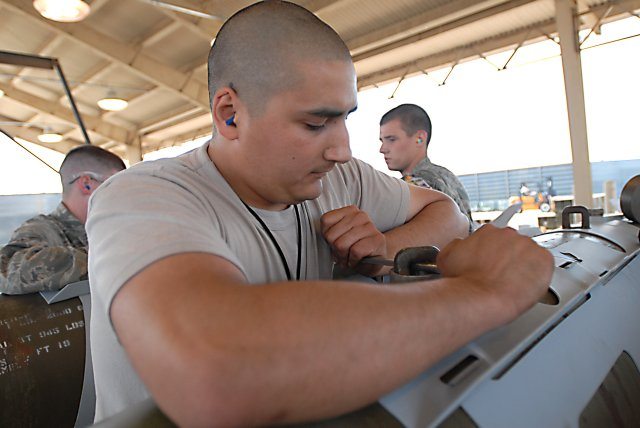The Combat Ammunition Production Exercise is underway here June 6 to 10, to test the 8th Fighter Wing Airmen’s capabilities to build munitions to support combat sorties.
Inspectors from across the Air Force, including instructors from the Air Force Combat Ammunition Center at Beale Air Force Base, Calif., evaluated approximately 200 Airmen on the processes and procedures for building munitions to support the wing’s operational plan. Munitions specialists from across Pacific Air Forces are here participating in the exercise.
“Basically, we’re executing our OPLAN,” said Senior Master Sgt. Victoria Lemke, the 8th Maintenance Squadron munitions materiel section chief. “PACAF has created this exercise, so we can show our capability to do what we do every day — we build bombs.”
While the exercise here this week focuses solely on producing combat loads for the F-16 Fighting Falcon and the F-15E Strike Eagle, both of which are currently on station at Kunsan Air Base, a real-world situation may call for the armament of a multitude of aircraft.
“(In the event of a real-world situation) the Army would be spun up too, so we would be supporting helicopters and the Patriot (Missile Defense Systems),” Sergeant Lemke said.
The process and evaluation, begins once the munitions control element gets the flying schedule and the aircraft tasking order. This order identifies the type and amount of each ordnance needed to complete the mission. Airmen check the standard configuration for the weapons and ensure everything is on-hand to fill the order, working around the clock to ensure bombs are ready when aircraft need to take off.
“Once we’ve made that determination of how many of each component we need, they load all the components up and deliver them to the bomb pads,” Sergeant Lemke said. Once the teams are in full production mode, the weapons builders should be ahead of the flying schedule.
“That’s your ultimate goal,” Sergeant Lemke said, “so you’re not holding up aircraft.”
Live ordnance isn’t physically loaded onto awaiting aircraft during the CAPEX, but the capability to build enough bombs on time is evaluated, along with the Airmen’s ability to accurately accept the munitions and maintain accountability of the ordnance. Once the bombs are built, transported and accepted, they are then taken apart and the components are returned to the storage area.
Airman 1st Class Bryan Permann, an 8th MXS munitions storage crew chief, works with a small team to return bomb components to storage after the process has been evaluated. Normally, this disassembly process would be moot for a live-fire mission, as the pilot takes care of bomb “disposal” over the target.
“As they say, we would just be another airliner if we didn’t drop munitions,” Airman Permann said. “But as a whole, I think it’s very important. You can see the amount of munitions and sorties that are generated and all of the different assortments of warheads, bombs and munitions we can actually drop on the enemy.”
All the while, the 8th MXS Airmen still support the 8th Fighter Wing flying schedule, as well as the flying schedule of the current theater support package — Royal Air Force Lakenheath. But the on-going CAPEX is important, Sergeant Lemke said, because it not only tests the 8th Fighter Wing Airmen’s capability but also provides an excellent training environment.
“We don’t get many opportunities to build live munitions (because) we just don’t have the capability at a lot of Air Force bases to drop live munitions,” Sergeant Lemke said. “This is an outstanding training opportunity for us. This is the perfect time to validate munitions tactics, techniques and procedures as well as to ensure we have the capability to do what U.S. Forces Korea needs us to do.”










